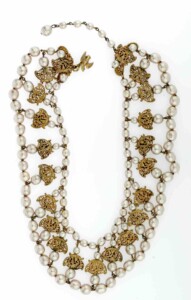Miriam Haskell Jewelry (1926-today)
Miriam Haskell was born in 1899 in Indiana, the USA to Russian Jewish immigrant parents. After completing high school in Albany, she studied for three years at Chicago University.
In 1924 she moved to New York and two years later, in 1926, Haskell opened a bijoux shop in the McAlpin Hotel, at times when costume jewelry was a relatively new genre. In the same year, she was joined by Frank Hess, the label’s designer from 1926 to 1960, an event that launched decades of sales of the finest handmade fashion jewelry. As a team they proved to be a perfect combination of business skills and artistic taste.
In the 1930s the company relocated to 392 Fifth Avenue and went on to open boutiques at Saks Fifth Avenue and Burdine’s, as well as stores in Miami and London. Celebrities, as well as ordinary people from all walks of life, have sought Haskell’s dazzling jewelry to treasure and wear. Public figures such as Joan Crawford, Lucille Ball, Gloria Vanderbilt and the Duchess of Windsor amassed large collections of Haskell jewelry. Crawford owned a set of almost every Haskell ever produced from the 1920s through to the 1960s. Her extensive collection was found, upon her death in 1977, meticulously labelled stored in her home and was later offered at auction.
Miriam Haskell’s handmade jewelry is characterised by its use of high-quality materials, such as Italian glass beads or Japanese imitation pearls (made out of glass). Seed beads or pearls strung on the thin wire were hand-threaded onto a metal base to cover it completely, producing an identifiable ‘tapestry’ effect, a technique typical of Miriam Haskell’s signature look.
The restrictions of World War II forced Haskell to use alternative materials including wooden beads, genuine seashells, crystals and plastic elements, all sourced closer to home. Later in the early 1950s, Haskell’s designs became increasingly elaborate and showy as women wanted a more obvious glamour in their lives after the deprivations of war. Huge necklaces had strands of multiple crystal beads separated by Japanese pearls, coral or huge gold-tone leaves, brooches were set with multiple stones, pearls and tiny glass seed beads in shades of aqua, robin’s egg blue and pastel pink.
Haskell bore no permanent signature between 1926 and 1947 using paper tags instead, while until 1949 only a fraction of her work displayed permanent marks. From 1950 onwards her brother, Joseph Haskell, introduced the first regularly signed Miriam Haskell jewelry.
Miriam Haskell’s jewelry is collected worldwide and is displayed in Museum collections such as that of the Metropolitan Museum of Art, New York.
